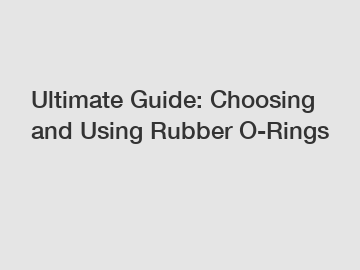Ultimate Guide: Choosing and Using Rubber O-Rings
The Ultimate Guide: Choosing and Using Rubber O-Rings.
Rubber O-rings are an essential component in many industries, serving as a seal to prevent leakage and maintain pressure in various applications. From hydraulic systems to automotive engines, their versatility and reliability make them a popular choice. However, with a wide range of options available, choosing the right type of O-ring might seem daunting. In this ultimate guide, we will explore everything you need to know about selecting and utilizing rubber O-rings.
Understanding Rubber O-Rings.

To begin, let's delve into the basics. Rubber O-rings are circular seals made from elastomers like nitrile, silicone, Viton®, EPDM, or neoprene. These materials possess excellent resistance to different chemicals, temperatures, and pressures, making them suitable for various environments. O-rings create a seal by compressing between two mating surfaces, preventing fluid or gas leakage.
Choosing the Right O-Ring Material.
Selecting the appropriate O-ring material is crucial to ensure its longevity and optimal performance. Here's a list of commonly used materials and their applications:
1. Nitrile (NBR): These O-rings are affordable, have good mechanical properties, and perform well in petroleum-based fluids or oils. They are commonly used in automotive fuel systems, hydraulic seals, and industrial applications.
2. Silicone (VMQ): Silicone O-rings have excellent temperature resistance and have low compression set. They are commonly used in food and beverage applications, medical devices, and electrical connectors.
3. Viton® (FKM/FPM): These O-rings are highly resistant to chemicals, oils, and extreme temperatures. They are ideal for applications requiring chemical resistance, such as aerospace, automotive, and chemical process industries.
4. EPDM: With excellent weathering resistance and flexibility, EPDM O-rings are frequently used in outdoor applications, cooling systems, and water processing.
5. Neoprene (CR): Neoprene O-rings exhibit resistance to ozone, sunlight, and oxidation. They are commonly used in hydraulic systems, refrigeration, and air conditioning.
Ensuring Correct Sizing.
To guarantee a proper seal, accurate sizing is essential. O-rings are typically measured using their inner diameter (ID) and cross-section diameter (CS). Proper measurement will prevent the O-ring from being overly compressed or not sealing properly. Various international standards such as AS568, ISO 3601, and JIS B2401 provide standardized sizes for O-rings.
Installation Techniques.
Proper installation is critical to maximize the effectiveness of rubber O-rings. Follow these steps for a successful installation:
1. Ensure the mating surfaces are clean and free from debris.
2. Lubricate the O-ring using a compatible lubricant to aid in assembly and reduce friction.
3. Carefully position the O-ring into the groove, avoiding twists or sharp bends.
4. Securely close or connect the mating surfaces to compress the O-ring adequately.
Maintenance and Inspection.
Regular maintenance and inspection are necessary to identify potential issues and avoid unexpected failures. Keep the following practices in mind:
1. Inspect O-rings visually for signs of wear, cracks, or distortion.
2. Regularly check for proper compression and alignment of mating surfaces.
3. Replace O-rings when they show signs of damage or when the application specifications demand it.
4. Store O-rings in a cool, dry location, away from direct sunlight or extreme temperatures.
Common Challenges and Troubleshooting Tips.
While rubber O-rings are designed for durability, challenges can still arise. Here are a few common issues and troubleshooting tips to help you tackle them effectively:
1. Extrusion: Excessive clearance between the mating surfaces can cause the O-ring to extrude. Choose a thicker O-ring or use backup rings to provide additional support.
2. Compression Set: Over time, O-rings can lose their ability to rebound after compression. Select materials with low compression set characteristics or opt for an alternative elastomer.
3. Chemical Incompatibility: Certain chemicals can degrade specific O-ring materials. Ensure the O-ring material is resistant to the chemicals present in your application to avoid compatibility issues.
Conclusion.
Rubber O-rings are indispensable components that play a critical role in maintaining seals and preventing leakage in a wide range of applications. By understanding the different materials, sizing, installation techniques, and proper maintenance, you can select and utilize rubber O-rings with confidence. Remember to consult with trusted suppliers or experts for specific recommendations tailored to your application needs. With this ultimate guide at your fingertips, you have all the information necessary to choose and implement the perfect rubber O-ring solution for your requirements.
The company is the world’s best neoprene bellows, wholesale rubber o rings, customized pu material polyurethane parts supplier. We are your one-stop shop for all needs. Our staff are highly-specialized and will help you find the product you need.
241
0
0

Comments
All Comments (0)